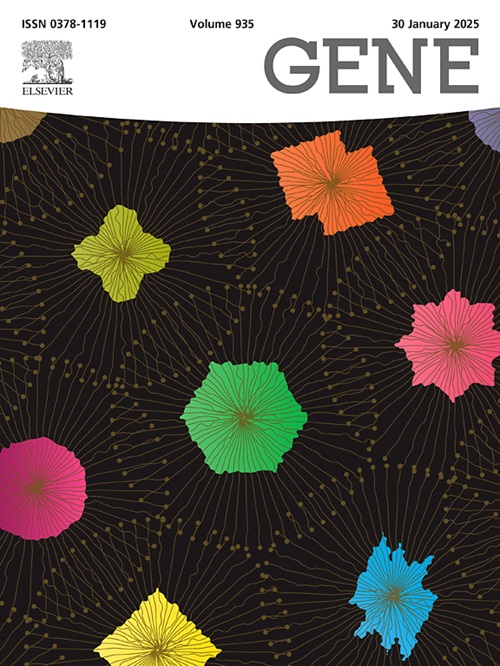Transcriptome analysis identifies potential molecular mechanisms for growth of fast muscle in Chinese perch juvenile
IF 2.4
3区 生物学
Q2 GENETICS & HEREDITY
引用次数: 0
Abstract
Chinese perch (Siniperca chuatsi) is an important commercial fish species in China. Understanding the molecular mechanisms of growth and development of skeletal muscle is helpful for selection breeding and improving the growth rate of Chinese perch. We analyzed histological and transcriptomic differences in fast muscle of Chinese perch between 30 days post hatching (dph) and 60 dph using histological sections and high-throughput RNA-Seq. The results showed that the diameter of muscle fibers in 30 dph Chinese perch was mainly distributed in range of 30 − 40 μm, and that of 60 dph was primarily in the range of 40 − 50 μm. 34 differentially expressed genes (DEGs) were identified in the fast muscle of Chinese perch between 30 and 60 dph, of which 9 were up-regulated and 25 were down-regulated (60 dph vs 30 dph). The DEGs, including MYH4, ENO3, Bag3, krt13 and krt18, are associated with muscle cell differentiation and fusion in Chinese perch. The analysis of the protein–protein interaction network of DEGs revealed that FOS, junb and EGR1 may involve in the development of fast muscle. KEGG enrichment results showed that the up-regulated genes in the 60 dph were associated with several pathways related to metabolism and protein synthesis, such as glycosphingolipid biosynthesis and aminoacyl-tRNA biosynthesis. The results suggest that the development of fast muscle in Chinese perch from 30 to 60 dph is accompanied by an increase in muscle fiber diameter and changes in gene expression related to muscle cell differentiation and protein synthesis.
Abbreviations: DEGs, differentially expressed genes; dph, days post hatching; FC, fold change; FDR, False Discovery Rate; GO, Gene Ontology; KEGG, Kyoto Encyclopedia of Genes and Genomes; MyHCs, Myosin heavy chains; qRT-PCR, quantitative real-time PCR.
转录组分析确定了中国鲈鱼幼鱼快肌生长的潜在分子机制。
鲈鱼是中国重要的商品鱼种。了解骨骼肌生长发育的分子机制有助于选育和提高鲈鱼的生长速度。我们利用组织切片和高通量RNA-Seq分析了孵化后30天(dph)至60天(dph)期间鲈鱼快肌的组织学和转录组差异。结果表明,孵化后30 dph中华鲈的肌纤维直径主要分布在30 - 40 μm之间,而孵化后60 dph中华鲈的肌纤维直径主要分布在40 - 50 μm之间。在中国鲈鱼快肌中发现了34个差异表达基因(DEGs),其中9个基因上调,25个基因下调(60 dph vs 30 dph)。这些DEGs包括MYH4、ENO3、Bag3、krt13和krt18,它们与鲈鱼肌肉细胞的分化和融合有关。DEGs的蛋白相互作用网络分析显示,FOS、junb和EGR1可能参与了快肌的发育。KEGG富集结果显示,60 dph的上调基因与代谢和蛋白质合成相关的几个通路有关,如糖磷脂生物合成和氨基酰-tRNA生物合成。结果表明,鲈鱼快肌在30 dph至60 dph的发育过程中伴随着肌纤维直径的增加以及与肌肉细胞分化和蛋白质合成相关的基因表达的变化。缩写:缩写:DEGs,差异表达基因;dph,孵化后天数;FC,折叠变化;FDR,错误发现率;GO,基因本体;KEGG,京都基因和基因组百科全书;MyHCs,肌球蛋白重链;qRT-PCR,定量实时 PCR。
本文章由计算机程序翻译,如有差异,请以英文原文为准。
求助全文
约1分钟内获得全文
求助全文
来源期刊

Gene
生物-遗传学
CiteScore
6.10
自引率
2.90%
发文量
718
审稿时长
42 days
期刊介绍:
Gene publishes papers that focus on the regulation, expression, function and evolution of genes in all biological contexts, including all prokaryotic and eukaryotic organisms, as well as viruses.
 求助内容:
求助内容: 应助结果提醒方式:
应助结果提醒方式:


